Seagate Backup Plus Portable 5TB & Backup Plus Slim 2TB Review: SMR for the Consumer Market
by Ganesh T S on June 18, 2019 8:00 AM ESTInvestigating SMR for Consumer Workloads
The nature of the platters in a hard drive (CMR or SMR), unless explicitly mentioned, is not immediately evident from the specifications or even artificial benchmark tests that use a small work set. Even replaying real-world work traces often only provides slight hints about the presence of SMR. Our first tryst with SMR in the lab was the 8TB Seagate Archive HDD, followed by the retail-focused Seagate Innov8. While the Archive HDD (one of the first SMR drives from Seagate that went into mass production) had dismal performance consistency, the Innov8 carried substantially improved firmware that enabled much better overall performance numbers. With the passage of time, Seagate has improved the firmware to such an extent that the tests detailed in the link above can no longer reliably detect the presence of SMR in a drive.
Detecting SMR - The Sequential Writes Test
One of the tests we have recently started doing on flash-based storage devices is performance consistency under extremely stressful sequential write workloads. The fio workload used for this purpose was adapted for running on the external hard drives. This 128K sequential write workload was set to span the entire capacity of the drive. First off, we take a look at the processing of this workload on a CMR drive - the WD My Passport 4TB.
We see the bandwidth numbers between 90 MBps and 110 MBps as we start off at the outer edge of the platters. We see a gradual steady drop down to 50-70 MBps as we move towards the center. This drop (based on the sector location in the drive's platters) is a well-known phenomenon due to the presence of a larger number of sectors on a per-revolution basis as we move further away from the center of the platter.
The Seagate Backup Plus Slim, on the other hand, starts off between 125 and 135 MBps and ends up between 60 and 80 MBps. Worryingly, we have drops down to 10 MBps frequently. It can be seen that the firmware tries to avoid these slow write scenarios as much as possible (almost a hour of sustained sequential writes), but, the amount of traditional PMR space in the platters eventually runs out and the drive is forced to record to the shingled space. This results in the drop of the instantaneous write rates to 10 MBps periodically.
The same behavior is seen in the Seagate Backup Plus Portable 5TB drive also.
The 5TB drive is actually able to avoid writing to the SMR space for more than 90 minutes before yielding to the inevitable.
Backing up System Images - A Real World Test
Sustained sequential writes for a hour or more are not realistic workloads for a majority of the retail consumers. However, it must be noted that the drop in transfer rates may start to happen after all the non-shingled areas are already filled with data. Thus, once the SMR drive is, say 20 - 25% full, it is likely that users will see considerably worse performance compared to a fresh drive. To test this, we brought back the LaCie Porsche Design Mobile 4TB (also a SMR drive) and filled it to around 14% of the capacity with system images of different PCs created using the System Image Backup native utility in Windows. The same data was also used to put the other hard drives in the 'used' state.
A system image of the testbed was then taken on the extrnal drive, while the read and write transfer rates to the drive were monitored.
The WD My Passport 4TB shows the system image write out being consistently between 70 MBps and 110 MBps. In contrast, the Porsche Design Mobile drive (of the same capacity) had frequent dips to around 20 MBps. The peaks were higher at 130 MBps. Despite the higher peaks, the LaCie Porsche Design Mobile took more time compared to the WD My Passport for recording the system image.
Graphs for the same scenario involving the Backup Plus Slim and Backup Plus portable show that the SMR issue is still exposed. However, the valleys are spread much farther apart compared to the LaCie Porsche Design Mobile from a couple of years back.
SMR drives do show higher peak performance numbers compared to CMR drives with the same capacity. However, the lack of performance consistency means that a CMR drive is a more predicable medium for typical consumer workloads in the long run.


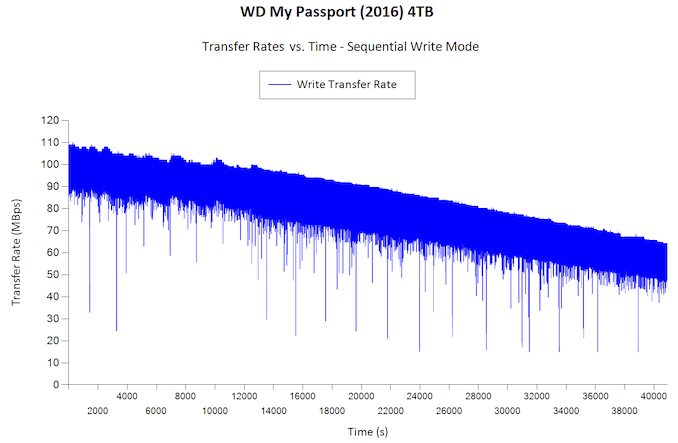


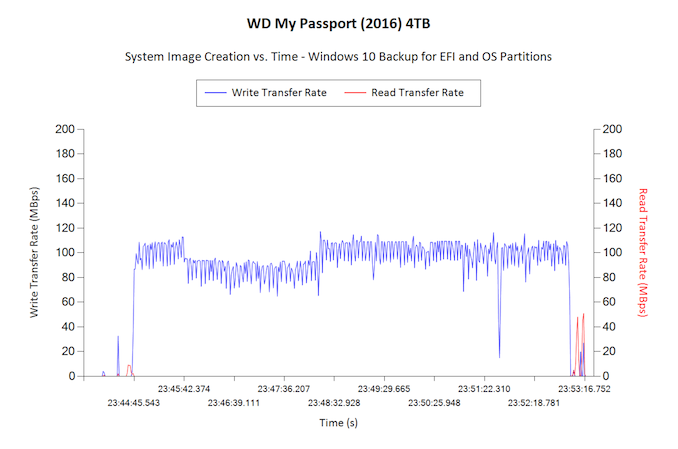
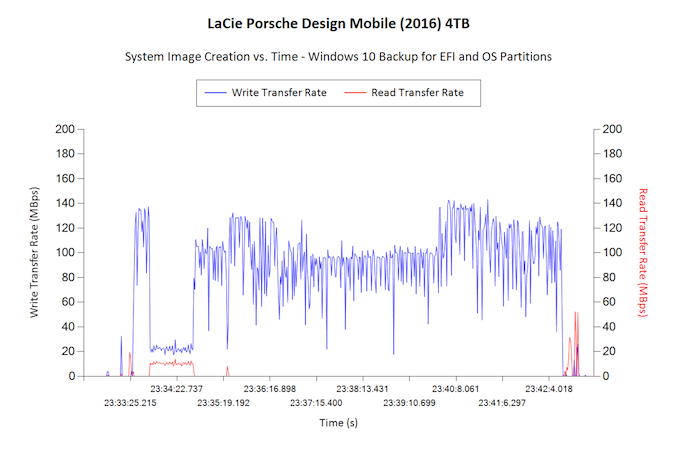
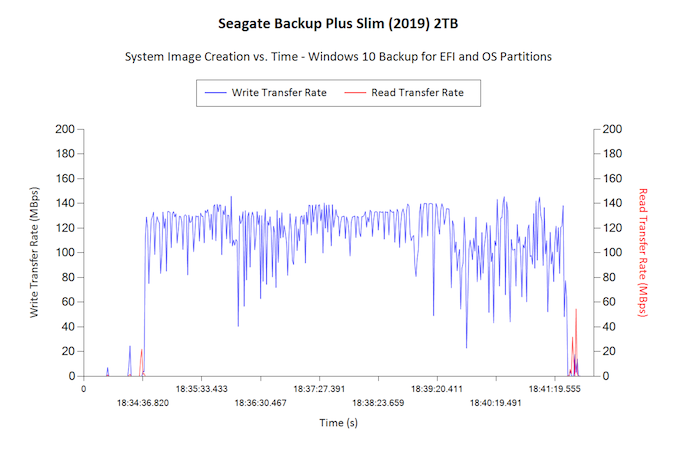
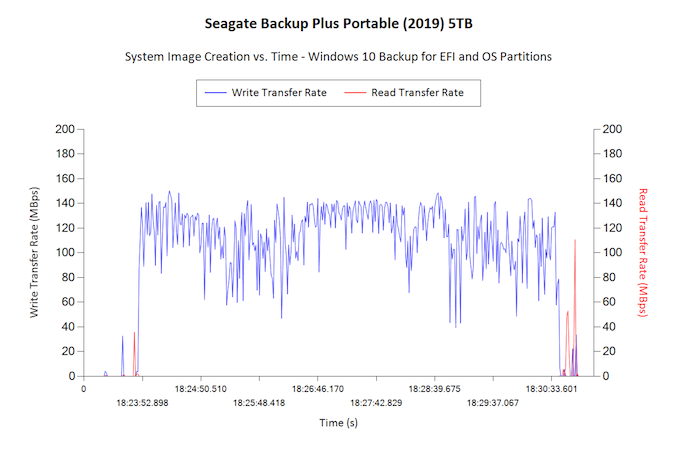








62 Comments
View All Comments
abufrejoval - Wednesday, June 19, 2019 - link
You seem to love holding on to your grudges. 5GB, that was a while ago. I used real SCSI back then.MDD1963 - Thursday, June 20, 2019 - link
5 GB? 1998 or so?oliwek - Thursday, July 4, 2019 - link
Or is it that his '10MB. Not GB' is in fact 10GB ? So the guy speaks about the 5TB drive from the article when he mentions 'having the 5GB' ? LOLHenry 3 Dogg - Sunday, January 30, 2022 - link
Every WD drive I've ever owned has died.My experiences with Seagate drives have been much better.
PeachNCream - Tuesday, June 18, 2019 - link
Pass because of the 3.0 micro-B connector. Those cables seem to fail an awful lot.Alistair - Tuesday, June 18, 2019 - link
ugh, can't believe it is micro, PASS!moozooh - Wednesday, June 19, 2019 - link
Idk what you guys are doing with your USB cables, but I haven't even managed to kill the connectors in my phone and tablet that I've been using every day (often putting them on the cable several times a day, in fact) for the past five years or so. And these are supposed to be backup drives—you don't have to disconnect them at all (and if you do, just pull the computer-side USB plug and don't touch the micro side). The Micro-B isn't great, but it's not THAT bad.Oliseo - Sunday, June 23, 2019 - link
This is the Internet, where sensationalism rules supreme. As soon as people say "seem", you know they're using Weasel words to disguise their own ignorance.badbanana - Tuesday, June 25, 2019 - link
+1Samus - Wednesday, June 19, 2019 - link
I've noticed that, too. A lot of the time I have trouble getting drives to connect - swapping in a different cable solves it.Amazing how some fragile crap like that got standardized, like the bulk of 80-pin PATA cables back in the day that couldn't communicate at ATA133 without corrupting drives, and initial SATA cable connectors that cracks on motherboards.